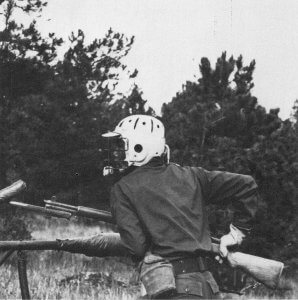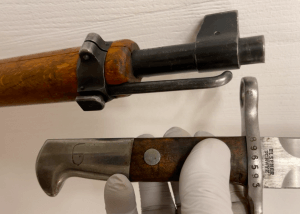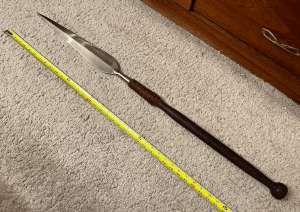Encyclopedia of Edged Weapons Terminology


Assegai–an African spear. Most assegais were longer, and intended for throwing. A shorter thrusting assegai called an iKlwa (see) became the signature weapon of the Zulu nation after Shaka kaSenzangakhona’s military reforms.
Basket Hilt–describes a series of Knuckle Guards and Cross Guards woven together elaborately to provide more complete protection for the hand than a single Knuckle Guard. Found on both Broad Swords and Rapiers, Basket Hilts were more commonly found on Broad Swords.
Bayonet–An Edged Weapon which mounts onto a long gun (usually a rifle or carbine, but sometimes onto a trench shotgun). When attached, a Bayonet converts the firearm into a short, field expedient spear (a type of Pole Arm). Combatants are only very, very rarely impaled upon bayonets, although historically, few have had the intestinal fortitude to stand their ground in front of a line of charging enemy troops with bayonets affixed to their rifles. Although Bayonet charges became far less frequent and effective after the invention of the machine gun, Bayonet training persists in some militaries as a means of inculcating fighting spirt, or Warrior Ethos. For a great deal of prolixity on the subject, read Bayonets in the De Chalybe Vulnifico (edged weapons–literally, “on the steel which causes wounds”) section of this website.

Bayonet Lug–An extension a few inches aft of the muzzle of a rifle (or shotgun) which permits a Bayonet to be affixed.

Clinch–A fight at grappling distance. Like freeways, often used in conjunction with “the,” e.g., ” . . . when in the clinch.” Spelled with an e (“clench”) in some of the literature.

Chop–A hacking attack, as with an axe, hatchet, machete, or bolo.

Cut–A slashing attack. Usually executed by dragging the edge of the blade across the target, pushing toward the edge side of the blade, while simultaneously pulling the blade in the general direction of the hilt. Cuts to the neck can be very dangerous, but as a general rule, cuts are less effective than thrusts. However, a cut may be useful in partially incapacitating an opponent by severing the muscles / tendons that enable the opponent to grasp (for example, the inside of the forearm or wrist) or move (groin muscle, or the back of the knee).
Contact Weapon–An instrument, such as a knife or club, that requires proximity, permitting direct contact between the weapon and the recipient, to injure. The “big 3” contact weapons are:
- Edged (anything that pokes or cuts)
- Impact (blunt instruments like baseball bats)
- Flexible (for example, a bike lock on a chain)
Crossguard, Cross Guard, or simply Guard–the closest part of a Hilt to the blade of an edged weapon. Typically a piece of metal, usually at a right angle to the blade, which prevents the operator’s fingers from sliding off the grip and onto the blade when the blade comes to a sudden halt. Has the added benefit of keeping the bad guy’s blade from sliding down your blade and onto the hilt, cutting your fingers. Longer Crossguards are called Quillions, especially when they are curved (see Hooked Quillion).

Cup Hilt–A Guard (or a sword that has a Guard) shaped like a bowl. Cup Hilts may not be the only Guard the sword has; they are often in front of a Cross Guard with long Quillions. Foils typically have Cup Hilts. Technically, “Cup Hilt” is a misnomer, as the entire handle (Guard, Grip, and Pommel) comprises the Hilt.

Dominant Hand–Your go-to hand. Most people are right handed. Even ambidextrous people tend to favor one hand or the other for particular tasks.
Dominant Side–the hand, arm, or side of your body corresponding with your primary handedness. I am right handed; thus my right side is my Dominant Side. My right hand is my Dominant Side hand.
Edge–The sharpened, cutting portion(s) of an Edged Weapon‘s blade; the part that shined like Meatloaf and his girlfriend in “Paradise by the Dashboard Light.”

Edged Weapon (EW)–a Contact Weapon that cuts or pokes, including knives, swords, spears, axes, and screwdrivers. When flung from a bow, a broadhead arrow is a Projectile. When held in the hands and thrust at an opponent within arms’ reach, without the assistance of a projectile launching bow, that same broadhead arrow is an Edged Weapon.

EDC (Every Day Carry)–What you have on you on a more or less daily basis. It might be handgun, and / or a folding knife, and / or a cell phone, and / or spare magazines, and / or house keys, etc.
Field Expedient–An improvised substitute for the real thing. If you don’t have a knife, you can use an ice pick, screwdriver, or (older style) potato peeler as a Field Expedient Edged Weapon (EW). A table lamp could be a field Expedient Impact Weapon. Rocks are Field Expedient Projectiles (when thrown) or Impact Weapons (when held in hand and used at grappling range).

Finial–A small sphere, ball, or disk of metal at the end of a Guard or Quillion.

The Finials on the Spanish M1907 bolo above are flattened into disks. I’m not sure if the term Finial would appropriately be applied to the little ball of metal at the tip of many metal sheaths. Image from International Military Antiques (ima-usa.com).
Foil–A piece of sporting equipment used in fencing, roughly equivalent to a Rapier.

Fuller–A groove running down the length of the blade. Often (and erroneously) called “blood grooves,” Fullers serve the purpose of lightening the blade while enabling it to retain some strength, the same way an I-beam uses less steel and is lighter than a rectangular block of steel, but still rigid enough to be used as a load bearing member in building construction. A blade with a Fuller may be described as “Fullered.” Most Fullered blades have two Fullers, one on each side, giving the blade a (very) roughly I-shaped cross section. Conserving steel was especially important throughout most of human history when there was far less of it.

Fullered–Adjective describing a blade that has one or more Fullers.
Gladius Hispaniensis–Roughly translated, Gladius Hispaniensis is Latin for “Spanish short sword.” A Gladius is a stubby, broad sword that became the signature weapon of the Roman legions. They did not invent it. When the Romans invaded the Iberian Peninsula, the Spaniards introduced them to the gladius from the receiving end. Realizing how effective a short thrusting weapon that left a wide deep wound was, the Romans standardized it throughout their army and built their tactics around it. The Romans were always quick to adopt what works, even from their enemies, as opposed to, say, the Spartans, who thought that bows and arrows were for wimps, because real men looked their enemies in the eyes (the Spartans also under-appreciated the importance of making babies in maintaining national power).
The gladius was never intended to be a hacker or a slasher, nor was it used much in that manner. Rather, it became part of the Romans’ overall method of fighting that involved close formations supporting each other with their shields, frequently rotating the front rank out so better rested soldiers could fill in from the rear after having had time to study the moves of the enemies to their immediate front. The Romans conquered much of the western world that way. It is believed that prior to the 20th century, the gladius killed more enemies than any other weapons system.
Grip–On an Edged Weapon, the Grip is the part of the Hilt that interfaces with the user’s hand.
Guard–Metal flanges designed to protect the hand of the wielder. Synonymous with Cross Guard.
Hilt–The handle of an edged weapon. The Hilt has three main components:
- the Crossguard (also called the Cross Guard, or simply Guard)
- the Grip
- the Pommel or butt end.
Hooked Quillion–A Quillion (narrow, extended portion of the lower Guard) that curves forward toward the underside of the blade. Allegedly Hooked Quillions can be used to trap an enemy’s bayonet and, with a quick twisting motion, bend or break the enemy’s blade between the curved Quillion and the thicker Ricasso at the base of one’s own bayonet blade–or at least, trap the enemy’s blade, or wrench his wrist. This probably works better in theory than it does in actual practice. Regardless, Hooked Quillions may be useful when “stacking” your rifle with those of your team. The 1907 pattern Enfield bayonets had Hooked Quillions, but like the three prong flash suppressor of the original M16s, they got caught on everything, including barbed wire and brush.

In October of 1913, the British Army staff handed down orders to stop producing bayonets with Hooked Quillions and for armorers to grind the Hooked Quillions off of existing bayonets. This was done piecemeal, and some 1907 pattern Enfield sword bayonets still have the Hooked Quillion, though they are rare. Far less rare are Hooked Quillions on bayonets for the Japanese Arisaka rifles, which almost universally had hooks (at least until steel shortages late in WWII might have led them to cut corners).

For more, see British P1907 / Japanese Arisaka / US M1917 Bayonets.
iKlwa–A short stabbing spear with a broad, leaf-shaped head. Unlike other assegais, the iKlwa did not have a long enough haft to balance against the weight of the spearhead that would make it suitable for throwing. Rather, like the Roman gladius hispaniensis short sword, it was primarily for thrusting at close range.

Shaka kaSenzangakhona, who established the Zulus as the major military power in SE Africa in the early 1800s, is sometimes credited with inventing the iKlwa. Modern historians think it more likely that, like the Romans when the Spaniards introduced them to the brutal effectiveness of short broad thrusting weapons (see Gladius above), Shaka recognized the iKlwa’s effectiveness and immediately standardized its issue and training throughout his expanding Zulu empire.
Knuckle Bow–A metal bar or Quillion that curves back from the Guard to protect the fingers of a sword wielder’s hand.

Kata–In martial arts, a Kata is a form: something you do to program certain motions into your subconscious reflexes, or “muscle memory.” Think Daniel-san’s “Wax on, wax off,” or Patrick Swayze by the lake in Road House. A fencer who warms up practicing lunges before a tournament is doing a kata.
Mortise–A slot (usually with a T-shaped cross section) in the back (Pommel) end of a bayonet. Sliding the Mortise onto the Bayonet Lug of a rifle (or occasionally, a shotgun) mounts the bayonet, turning the gun and knife combination into a short, field-expedient spear.


The mounting slot of this Spanish Machete Bayoneta Modelo 1964 is unusual in that it has a rectangular cross section, to interface with the CETME bayonet lug.
Muzzle Ring–the circular portion of a bayonet’s Crossguard that fits around the muzzle of a rifle.

Parry–To Off-line a bad guy’s weapon just far enough and just long enough to slide in past it and counter attack, or Riposte. Parrying the other guy’s gun is not usually very effective when going Empty Hands against The Drop; it’s better to get control, and keep control of the other guy’s muzzle direction rather than just swatting it away. However, with a fencing foil against another fencing foil, a rapier against another rapier, or with a rifle against an impact weapon or other rifle, the Parry can be quite effective–IF practiced sufficiently.

Pell–A post, sometimes wrapped in a thick material like carpet or old blankets, that you can use as a practice target for Edged, Flexible, or Impact weapon training.

Pommel–The back end of a knife, bayonet or sword. One of the three main components that comprise the Hilt.
Primary–In the tactical arena, one’s Primary is their go-to weapon. For an infantryman, that might be a rifle or machine gun. If s/he his dual armed, their Secondary might be a pistol. If not, it might be a knife or a bayonet.
Purpose Built–A tool designed and manufactured for the reasons you use it. Examples would be a fighting knife, as opposed to kitchen cutlery. You might grab a steak knife out of the butcher block on your counter if there is a home invader in your dining room, but it is more likely to break, and won’t make as wide a wound, as a Purpose Built fighting knife.
Quillion–A long Crossguard of an edged weapon. On a bayonet, the Quillion is on the opposite side from the Muzzle Ring. See also Hooked Quillion. For more information, see Appendix III of Bayonets.

Rapier–A long, skinny sword. As plate armor became more common and better designed, with fewer gaps or weaknesses, swords (which previously had wide blades to hack through leather armor or mail) slimmed down to squeeze through tiny openings between the other guy’s armor plates. Even Broad Swords were slimmer in the Renaissance than they had been during the Middle Ages, but the Rapier was skinnier still.

Rapiers, sometimes called dueling swords, can cut (especially with a lashing tip), but were primarily intended as thrusting weapons. Rapiers were more often carried by civilians, as soldiers preferred heavier bladed Broad Swords, which were less fragile and more general purpose.
Ricasso–The flat part of an edged weapon’s blade, in front of the guard but behind the sharpened portion (the Edge or Edges). Ricassos often contain manufacturer’s markings.

Riposte–an immediate counterattack. Usually performed after evading, Parrying, or controlling the other guy’s attack.
Secondary–a backup gun. If your Primary is a Glock 17, you might carry a Glock 26 or a J-frame Smith snubbie as a Secondary. If your primary is a rifle or carbine, your duty pistol will be your Secondary. A secondary weapon need not be a firearm. Most pistoleros carry a folding knife as a secondary.
Support hand–The hand that does not need to be on the pistol. Usually, but not always, your “weak” or non-dominant hand.
Support Side–Your NON-dominant side. We used to call it your “weak” side, but you should not have a weak hand or arm. Changing our words will not make that so, but extensive support side practice will. Your “Support” Side may or may not be actively engaged in supporting your dominant hand or arm. Clint Smith calls the non-dominant side the Opposite Side.
Tang (of a Knife or Sword)–An extension of the blade that fits into the hilt allowing the three components of the hilt (guard, grip and pommel) to be attached to the blade.

See Glossary of Gunspeak for the Tang of a pistol.
Thrust–A lunging attack, in line with the longitudinal axis of the blade. Thrusts result in deep, penetrating trauma. They can be parried, but are generally the most lethal EW attacks

“Stick ’em with the pointy end.”
–“Jon Snow,” in Game of Thrones
Tom and Jerry drill–A very simple Heloderm demonstration you can do in your kitchen or dining room. Set parameters preventing escape (for example, “the kitchen door is out of bounds”). Defender or student starts on one side of the table, set of chairs, or kitchen island. Assailant role player is armed with a “contact weapon” (it can be a wooden spoon; we use short pieces of foam pool noodle or pipe insulation or a rubber knife). Goals are simple: Assailant tries to touch the defender with the “contact weapon;” defender tries not to get touched. Fitness plays a part, but almost inevitably, the assailant eventually wins.

The lesson here: as Steinbeck said, “there is no victory in defense” alone. If you don’t take the fight back to the bad guy (in real life, by drawing a gun, grabbing a knife out of the butcher block, or whacking his forearm with a rolling pin), he will eventually catch up. See FAST in the Glossary of Gunspeak.
Touch Weapon–Another word for Contact Weapon

Use of Force–A very complex, and VERY misunderstood, subject. Use of Force is any time you are trying to stop an assailant’s aggression, whether you are threatening to shoot him if he gets any closer, or pushing him away, or kicking him in the knee, or head butting him, or stabbing him. Various, often nebulous, laws apply to when and how much force is justified in different situations. We address these concepts and laws, and put them into practice with role playing exercises, in our May / Can / Should: Lawful Use of Force classes. We touch on Use of Force in our other courses as well.
The X–Where you were when the attack started. Most fights start as ambushes. The X is the kill zone of the ambush.

If some of the above definitions and photos look familiar, it’s because many of them are laid out in equal or greater detail in relevant articles on this website. As with everything else on heloderm.com, this information is here to help you improve, but it is no substitute for actual practice under the tutelage of a qualified instructor.
